Nyheter
Tokenization Is Bringing Wall Street On-Chain
Publicerad
5 månader sedanden

Blockchain-based tokenization is transforming asset ownership and investment by enabling fractional access to luxury real estate, seamless trading of commodities like gold, and participation in private equity markets with the simplicity of digital transactions. As 2025 emerges as a watershed year for the industry, this sector is rapidly accelerating due to technological breakthroughs, regulatory advancements, and institutional adoption. This innovation is redefining ownership models and financial participation—converting traditionally illiquid assets into liquid investments while democratizing access to high-value markets.
With projections suggesting a $5T tokenized asset market by 2030, key industry players are rolling out groundbreaking platform upgrades and strategic initiatives, underscoring tokenization’s transformative role in global finance. Thus, we thought now is an opportune time to delve into how this innovation is reshaping financial markets and opening unprecedented opportunities for individuals and institutions alike, positioning tokenization as a cornerstone of modern economic infrastructure.
Before we delve into what the landscape looks like, let’s briefly give a breakdown of some of the benefits of tokenization for businesses and end-investors alike.
For Businesses
Cost Savings & Operational Efficiency
• Blockchain eliminates intermediaries, reduces costs, and speeds up transaction settlement.
• Real-time settlements could save financial institutions $20B annually by avoiding traditional T+2 delays, according to research from McKinsey.
• HSBC achieved:
o 90% cheaper bond issuance.
o 40% lower fundraising expenses compared to traditional methods.
• Citi’s Integrated Digital Assets Platform (CIDAP) with Maersk:
o Streamlined trade finance from days to minutes using tokenized smart contracts while reducing administrative burdens.
Enhanced Liquidity & Market Reach
• Tokenization enables fractional ownership, unlocking capital in illiquid assets such as private equity and real estate.
• Tokenized shares led to significantly faster fundraising and broader investor reach.
• $250T in marketable securities could be used as collateral, but only $28.6T is utilized.
• Distributed ledger technology in collateral management could unlock $100B+ annually, boosting liquidity and accessibility.
Improved Transparency & Streamlined Compliance
• Tokenization can significantly cut compliance costs, with the financial sector spending $181B annually.
o Reduces expenses by up to 50% through programmable rules and streamlined audits, dropping times by 30% and proving tokenization’s efficiency.
o They can automate otherwise manual work, for example, digitized identity verification lowers onboarding costs by 30-50% while maintaining privacy.
o Blockchain audit trails & automated screening reduce money laundering risks by 26%, while standardized workflows & verifiable credentials cut cross-border AML checks by 60%.
For End-Investors
• Tokenization benefits end investors by:
o Enhancing security and user experience.
o Increasing access to investment opportunities by lowering entry barriers.
o Providing greater liquidity, cost savings, and improved transparency.
• Key advantages include:
o 24/7 trading and near-instant transaction settlements, completing transactions in minutes versus the traditional T+2 cycle.
o Automation of yield opportunities across diverse assets via blockchain programmability, reducing manual intervention and overhead.
• Facilitates secondary markets for private credit and real estate:
o Shortens lock-up periods, and enables faster exit opportunities.
For the Underlying Blockchain
• Tokenization drives mainstream blockchain adoption and expands financial market utility, while amplifying its network effects.
• By converting real-world assets into digital tokens, blockchains gain access to trillions of dollars in previously illiquid or fragmented capital.
• Tokenization leverages blockchain’s strengths: transparency, security, and decentralization.
o Reduces intermediaries, streamlines transactions, and enables fractional ownership.
o Attracts institutions and governments, modernizing infrastructure and improving capital mobility.
• Tokenized assets create hubs for diverse financial instruments and foster seamless integration with decentralized finance (DeFi).
• Helps onboard mature assets into the crypto ecosystem.
• Drives the development of robust regulatory frameworks to address fraud and compliance concerns.
• Expected to evolve into the foundational settlement layer for global economies, which is projected to drive $291B in network revenues by 2030.
Why are we talking about this now?
Since our last Tokenization Report in October 2023, the total tokenized market has nearly doubled in value, growing from $8.8B to $17.2B.
Figure 1: Total Market Value of Tokenized Real-World Assets

Source: RWA.xyz
Meanwhile, the number of Real-World Asset (RWA) holders has increased by more than 100%, growing from almost 35K to 72K users. In fact, since the inception of this industry, more than 70M users have interacted with and at least used once with a tokenized product.
Figure 2: Adoption of Tokenized Real-World Assets: New and Cumulative Users

Source: 21Shares, Dune
With this perspective in mind, the sector’s growth has been primarily driven by tokenized government securities and private equities. Protocols catering to these segments continue to dominate market share, as illustrated in Figure 3 below.
Figure 3: Breakdown of Tokenized Real World Assets by Type

Source: 21Shares, RWA.xyz
The global financial sector is witnessing accelerated adoption of tokenization, with major institutions migrating traditional funds onto blockchains and established players developing supporting infrastructure. This shift spans asset management, banking services, and regulatory frameworks, reflecting broader industry transformation. This includes:
Institutional Tokenization Initiatives
• Asset managers like BlackRock, Hamilton Lane, Franklin Templeton, and WisdomTree now offer blockchain-based versions of conventional investment vehicles.
• Singapore’s Monetary Authority (MAS) spearheads Project Guardian, testing 15+ tokenization use cases across bonds, asset management, and treasury operations.
Banking Infrastructure Expansion
• HSBC deployed its Orion platform for tokenized deposits and gold transactions.
• UBS introduced its “UBS Services” for tokenizing bonds, funds, and structured products.
• DBS introduced its comprehensive “Token Services”, which features programmable rewards, treasury tokens and conditional payment solutions.
• Settlement giants Euroclear and DTCC have partnered to develop tokenized asset management frameworks, including but not limited to collaborations with crypto service providers like Chainlink.
Further, the United States is adopting a more favorable stance towards crypto, which is particularly significant for tokenization, as the country leads in the on-chain deployment of tokenized funds across treasuries and institutional investments, with a 61% market share. For example, President Trump recently signed the Executive Order ”Strengthening American Leadership in Digital Financial Technology,” which promotes the responsible growth of digital assets, blockchain technology, and related innovations across various sectors. This initiative also established the Working Group on Digital Asset Markets to develop a comprehensive federal regulatory framework for the industry, including tokenization. Additionally, the SEC has begun relaxing rules for banks to provide crypto custody services, paving the way for greater institutional participation in tokenized markets. With these developments, 2025 is poised to be a pivotal year for tokenization, with expectations that its influence begins extending beyond finance into sectors such as energy, intellectual property rights, commodities, and real estate.
Without delay, let’s analyze the top-performing sector: Government Securities.
The sector experienced remarkable growth over the past two years, driven by the high interest rate environment. Assets under management surged from approximately $700M to $3.5B, marking a 400% increase. Meanwhile, the user base expanded from around 700 to 13,000 unique holders, representing a staggering 1,757% growth, as shown in Figure 4 below.
Figure 4: Total Number of Tokenized Treasury Holders

Source: RWA.xyz
Across this vertical, Ethereum retained its dominance, bolstered by its deep liquidity and unmatched network security, which have made it the preferred choice for institutions to launch their initiatives before potentially exploring alternative networks. This reinforces our thesis that Ethereum will remain the de-facto platform for institutional adoption, even as emerging networks like Solana and Aptos gain traction and pose increasingly stiff competition.
Figure 5: Breakdown of Tokenized Government Securities by Blockchain
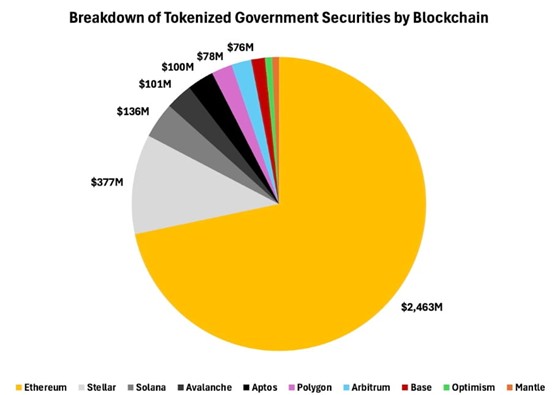
Source: 21Shares, RWA.xyz
In terms of projects, Franklin Templeton’s BENJI product dominated the market. However, Ondo has since established itself as one of the leading protocols, thanks to its diverse suite of offerings that have solidified its position in the industry, as seen below.
Figure 6: Breakdown of Tokenized Government Securities by Project
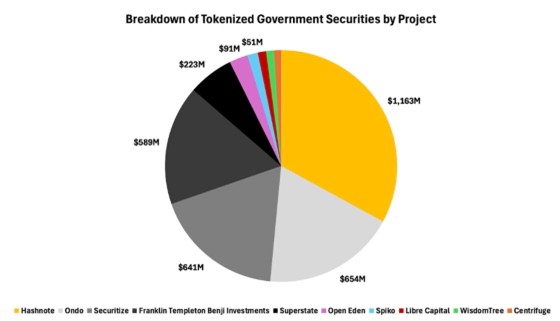
Source: 21Shares, RWA.xyz
Looking ahead, we expect Ondo to dominate a much bigger market share, building on the latest announcements and upgrades they unveiled at their new annual summit in New York. Specifically, they revealed two products:
OndoChain: A hybrid blockchain that blends permissioned security with public accessibility, ensuring compliance, security, and open access to tokenized markets. Advised by industry leaders such as BlackRock, PayPal, Morgan Stanley, Franklin Templeton, WisdomTree, and McKinsey, it leverages expertise from top financial and technology institutions, with key features including:
• Permissioned Validators: Validators are run by financial institutions and carefully monitored to prevent unfair practices and protect investors, such as front-running, ensuring compliance. Validators also provide real-time, reliable data like asset prices and interest rates onchain, improving transparency and efficiency while reducing the risk of manipulation.
• Staking with RWAs: Tokenized RWAs, like U.S. debt securities (USDY), will secure the network. Validators must stake external assets, similar to how broker-dealers post high-quality collateral in traditional finance, ensuring compliance and alignment. RWAs can also be used in DeFi activities like borrowing, lending, and staking while maintaining traditional mechanics. Institutions can pay transaction fees in RWAs, offering predictable costs and easing adoption for regulated players.
• Omnichain Bridging: The network enables smooth transfers between Ondo Chain and various blockchains (e.g., Ethereum, Solana, Cosmos). A decentralized verifier system ensures secure cross-chain RWA operations without relying on intermediaries or escrow contracts. This consolidates liquidity on Ondo Chain, avoiding fragmentation, which is crucial as it addresses the problem of RWAs issued across multiple chains. This can be seen in Ondo’s TVL being scattered across several networks, as depicted in Figure 7.
Figure 7: Breakdown of Ondo’s Total Value Locked by Blockchain
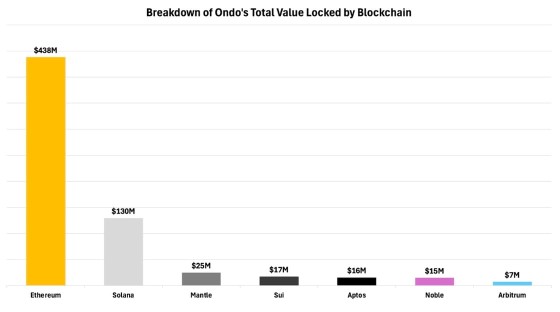
Source: 21Shares, DeFiLlama
Ondo Global Markets (GM): A global investment platform that tokenizes U.S. stocks, ETFs, and mutual funds to eliminate traditional market fragmentation and high fees—leveraging stablecoin-inspired efficiency. It enables 24/7 cross-border trading outside the U.S. while ensuring regulatory compliance. The platform’s key features include:
• Vast Range of Tokenized Real-World Assets: Provides 1:1-backed tokens representing U.S. securities like Apple, Tesla, S&P 500, and mutual funds among others. These tokens will be freely transferable on secondary markets outside the U.S., similar to stablecoins.
• Instant Minting and Redemption: Investors can convert securities into tokens (and vice versa) instantly, mirroring the liquidity of the underlying assets.
• DeFi Integration and Composability: Tokenized assets can be used as collateral for loans, staking, or yield generation in DeFi protocols, enabling cross-collateralization with crypto assets and expanding the universe of assets within DeFi.
• Institutional-Grade Infrastructure: Integrated compliance features, including AML controls and proof-of-reserves verification, enable regulatory compliance while providing token holders access to institutional securities lending markets, with full yield distribution.
• Built-In Access to Margin: Borrow against tokenized holdings at competitive rates typically accessible only to traditional institutional investors.
All in all, while Ondo’s upgrade presents significant growth potential, three key risks warrant attention. First, its novel reliance on RWAs for network security remains unproven at scale, exposing vulnerabilities to value fluctuations from market volatility or interest rate changes. Second, the permissioned validator system introduces centralization risks. If Ondo’s proprietary oracle faces attacks or manipulation attempts, its entire ecosystem could collapse without third-party safeguards like using external validators such as Chainlink’s Oracle Network. Finally, despite addressing liquidity fragmentation through its omnichain architecture, the effectiveness of Ondo Bridge and its Decentralized Verification Network in mitigating this risk remains speculative until real-world implementation. These challenges demand cautious optimism as the platform begins to roll out.
Private Credit
While government securities dominated in 2023 and 2024 with explosive growth, another sector was quietly gaining momentum in the background — now emerging as the largest real-world asset category after stablecoins. That said, as highlighted in our 2025 Market Outlook, private credit remains one of the industries primed for further disruption this year. To recap, tokenizing this sector enables:
• Secondary Market Activation: Tokenization enables 24/7 trading of private credit positions and equity, reducing the 180–360-day settlement cycles typical in traditional markets. For example, Victory Park Capital tokenized $1.7B in private credit on zkSync, allowing instant fractional trading of SME loans previously locked for 5–7 years while democratizing exit strategies via token sales instead of a full portfolio exit.
• Fractional Ownership: By breaking private credit investments into smaller tokens, investors can trade portions of their holdings, improving liquidity. In fact, the Coalition Greenwich survey found that 70% of investors cited liquidity as a barrier to investing in private credit.
• Streamlining Operational Workflows: By automating manual processes like compliance checks, capital calls, and loan servicing, administrative burdens are minimized. Bain & Company estimates that tokenization could unlock $400B in value for alternative investments through automation, while Deloitte demonstrates that digitizing workflows via tokenization reduces operating costs for asset managers overseeing private credit funds.
• Enhancing transparency: Tokenization tackles private credit’s longstanding transparency challenges by leveraging blockchain’s real-time auditability. While 43% of investors avoided private credit in 2023 due to opacity concerns, distributed ledger technology now enables granular tracking of loan terms, collateral status, and payment flows via public blockchain records.
• Collateral Optimization: Smart contracts enable cross-chain collateralization (e.g., using tokenized real estate as margin for private loans), reducing liquidity premiums by around 30% compared to conventional escrow arrangements
All in all, tokenized private credit markets are expanding rapidly, with protocols like Tradable, Maple, and Figure Network driving adoption, as seen below.
Figure 8: Total amount of Active Loans on Private Credit Markets

Source: RWA.xyz
Zooming in, tokenized private credit surged 66% over 18 months to reach its current $11.8B valuation. The Figure Network dominates onchain private credit with $8.8B in active home equity loans, representing 92% of the market. Meanwhile, Tradable has emerged as a major player, tokenizing $1.7B in alternative assets like private credit funds, while as shown below, Maple Finance tripled its TVL to over $550M, shown in Figure 9, in the last six months through institutional debt pools offering yields above 18%.
Figure 9: Total Value Locked on Maple
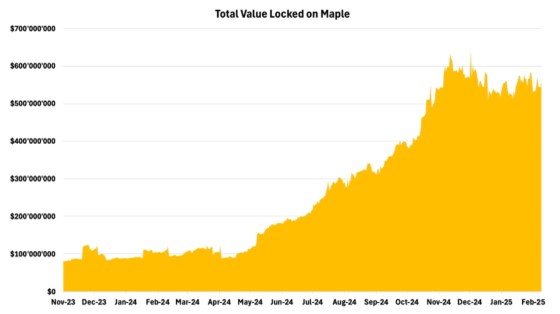
Source: 21Shares, Dune
Higher investment returns will be a major catalyst for this sector’s growing adoption, as users embrace greater risk in pursuit of credit yields—currently averaging more than twice the return on U.S. Treasuries, which are expected to decline further in the coming months.
To recap, government securities and private credit currently lead in tokenized asset growth, driven by institutional adoption and regulatory advancements. Initiatives like Ondo’s new developments are expected to accelerate this trend, alongside a favorable macro environment attracting further capital inflows. While government securities and private credit dominate today, real estate and private equity are poised to gain momentum as the industry matures. With a projected $5T tokenized asset market by 2030, the sector is primed for continued expansion, reshaping finance, streamlining operations unlocking unprecedented opportunities across several asset classes, all on–chain. As adoption grows, tokenization not only democratizes high-value markets but also solidifies blockchain’s role as a cornerstone of global financial infrastructure.
What’s happening this week?
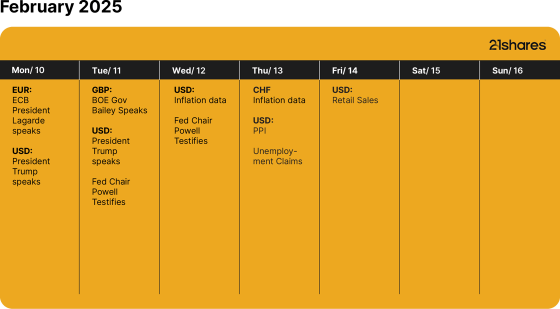
Research Newsletter
Each week the 21Shares Research team will publish our data-driven insights into the crypto asset world through this newsletter. Please direct any comments, questions, and words of feedback to research@21shares.com
Disclaimer
The information provided does not constitute a prospectus or other offering material and does not contain or constitute an offer to sell or a solicitation of any offer to buy securities in any jurisdiction. Some of the information published herein may contain forward-looking statements. Readers are cautioned that any such forward-looking statements are not guarantees of future performance and involve risks and uncertainties and that actual results may differ materially from those in the forward-looking statements as a result of various factors. The information contained herein may not be considered as economic, legal, tax or other advice and users are cautioned to base investment decisions or other decisions solely on the content hereof.
Du kanske gillar
-
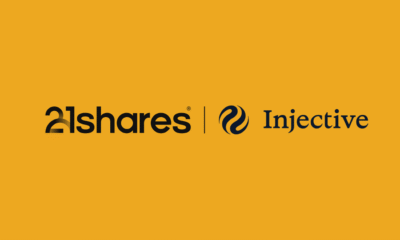

Primer: Injective, infrastructure for global finance
-
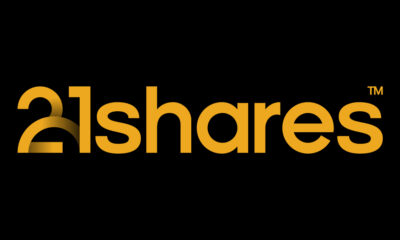

Bitcoin is resilient despite the Middle East war
-


Svenska investerare — 21Shares Nasdaq Stockholm-sortiment har just blivit starkare
-


UK looking to lift the retail ban on crypto ETPs
-
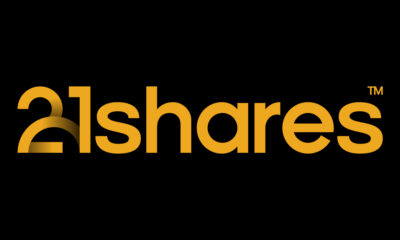

21Shares noterarar fem nya krypto-ETPer Nasdaq Stockholm
-
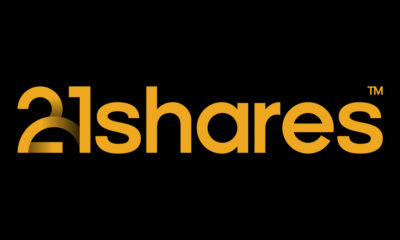

Bitcoin ETFs are cheaper than crypto stocks. Here’s why

De senaste månaderna har det varit större förändringar på denna lista än normalt. Under juni 2025 förändrades listan på de mest eftersökta ETFerna åter kraftigt, vilket numera är ganska normalt. Denna månad var det hetaste investeringstemat i månadsutdelande ETFer . Vi noterar är att Montrose befäster sin position som den populäraste ETFen på Etfmarknaden.se samtidigt som listan är mer koncentrerad än tidigare.
Det går att handla andelar i dessa ETFer genom de flesta svenska banker och Internetmäklare, till exempel Nordnet, SAVR, DEGIRO och Avanza.
Månadsutdelande fonder tilldrar sig stort intresse
Den 6 november förra året, bara dagar efter att vi publicerat en artikel om månadsutdelande fonder, lanserade JP Morgan en helt ny variant av en månadsutdelande fond. JPMorgan US Equity Premium Income Active UCITS ETF USD (dist) (JEIP ETF) med ISIN IE000U5MJOZ6, är en aktivt förvaltad ETF.
Den börshandlade fonden investerar i företag från USA. Ytterligare intäkter söks genom användning av en överlagringsstrategi med derivatinstrument. Denna ETF strävar efter att generera en högre avkastning än S&P 500-index.
Detta ledde till att vi fick uppdatera vår artikel om månadsutdelande fonder med JEIP men också med JPMorgan Nasdaq Equity Premium Income Active UCITS ETF USD (dist) (JEQP ETF) med ISIN IE000U9J8HX9, som är en aktivt förvaltad ETF, men som mäter sig mot Nasdaq-100 istället.
Under den sista veckan i februari 2025 noterade Montrose den första svenska ETFen på fem år. MONTDIV ETF är Sveriges första månadsutdelande ETF och rusade snabbt på listan efter de mest eftersökta börshandlade fonderna på vår sida. Det finns emellertid en hel del andra ETFer som ger utdelning varje månad. Vi uppdaterar löpande denna artikel.
När kommer utdelningen från MONTDIV?
Som nämnts så är MONTDIV den allra populäraste börshandlade fonden på vår sida. Tillsammans med sin syster ETF, MONTLEV, är de även populära på andra håll. Fram till idag har MONTDIV lockat närmare 300 miljoner kronor och seglat upp som den tredje mest ägda i Sverige. Dessutom stod Montroses två ETFer för vart fjärde ETF-avslut på Stockholmsbörsen (ex. Bull/Bear-produkter) under perioden mars-april 2025. Det ser vi som ett kvitto på att det finns en stor efterfrågan på börshandlade fonder.
ETP, ETF, ETC, ETN, ETI
Många är osäkra på terminologin när det gäller börshandlade produkter och vi ser dels hur de söker – och hittar många av de informativa artiklar som vi skrivit på Etfmarknaden.se, men också vår ordlista som förklarar det mesta som kan verkar förvirrande. En av våra äldre artiklar, Vad är vad? ETP, ETF, ETC, ETN och ETI från september 2012, har nu helt plötsligt dykt upp som en av de mer lästa artiklarna.
Fortsatt intresse för försvarsfonderna
Vilken ETF för försvarsindustrin är bäst och hur investerar man i denna sektor med hjälp av börshandlade fonder? I dag finns det flera ETFer som ger exponering mot flyg och försvar som följer tre olika index. De årliga förvaltningskostnaderna ligger 0,35 och 0,55 procent. Vi har skrivit en artikel om olika försvarsfonder. Du hittar mer om ETFer för försvarsindustrin här.
Utöver detta har samtliga de större aktörerna lanserat en en börshandlad fond för den europeiska försvarsindustrin vilka alla blirvit stora succcéer.
Inte längre populärast av dem alla
XACT Norden Högutdelande är utan tvekan en av de mest populära av alla de ETFer som vi har skrivit om på vår sida. Den kvartalsvisa utdelningen och dess satsning på aktier med en låg volatilitet och hög direktavkastning gör det till en populär fond som återfinns i mångas depåer. Nyligen lämnades årets andra utdelning från denna börshandlade fond.
Hur högt kommer vi när du Googlar på ordet ETF?
Under maj 2025 såg vi många sökningar på begreppen ETF, börshandlad fond och Etfmarknaden. Om det var vår egen sida eller om det var den totala marknaden för ETFer som besökarna sökte på vet vi inte, men efter att ha fått mail från en av de större emittenterna vet vi att de försöker kartlägga de svenska placerarnas exponering mot börshandlade fonder.
Om du söker på ordet ETF på Google, hur högt hamnar vi då?
Investerna söker information om försvarsfonder med fokus på Europa
Wisdomtree har under året lanserat en försvarsfond som investerar i europeiska företag, vilket även HANetf har gjort, kortnamnet är ARMY i London och 8RMY på tyska Xetra.
Populariteten för europeiska försvarsbörshandlade fonder (ETF:er) har ökat kraftigt på senare tid, drivet av betydande inflöden som återspeglar ett växande investerarintresse för sektorn. Dessa imponerande inflöden understryker det ökande erkännandet av försvarssektorns tillväxtpotential mot bakgrund av den nuvarande geopolitiska dynamiken.
SAVRs ETF-satsning skapar stort intresse
SAVR har precis valt att lansera handel med börshandlande fonder. SAVR som tidigare varit kände för att erbjuda handel med traditionella fonder har nyligen valt att lansera handel med aktier, men också med ETFer på framför allt tyska Xetra. På denna marknad erbjuder nu SAVR med flera ETFer än vad både Nordnet och Avanza gör.
Samtidigt har SAVR valt att lansera en egen produkt tillsammans med amerikanska Vanguard, SAVR Global by Vanguard.
Halalfonder är nu hetare än ESG
Tidigare var det många som sökte på begreppet ESG, men detta sökord har fallit från listan under de senaste månaderna. En variant av ESG-fond är de fonder som har en islamistisk inriktning, så kallade halalfonder, och det är fortfarande något som våra besökare letar information om. En sådan fond är ASWE, som är en aktivt förvaltad shariafond men till exempel HSBC har en serie fonder med fokus på att investera enligt islam. Det är ingen speciell enskild fond som sticker ut och lockar mer än andra.
Går det att handla ETFer hos Swedbank?
Swedbank ETF tror vi kan tolkas att det endera finns intresse för att veta om Swedbank har ETFer i sitt utbud, eller om det går att handla börshandlade fonder på Swedbank. Svaret på denna fråga återfinns här.
Räntesänkningar ökar intresset för fastigheter
Ett annat begrepp på listan är ETF fastigheter. Allt fler investerare tror att vi kommer att få se ytterligare räntesänkningar, inte bara i Sverige och Europa, men även i USA. Lägre räntor gör det enklare att räkna hem en investering i fastigheter. Kan det vara så att våra besökare undersöker möjligheterna att positionera sig i en ETF för fastigheter innan räntorna sänks för att de tror att det kommer att leda till en uppvärdering av fastighetsbolagen? Vill du ha några idéer så skrev vi en text om börshandlade fonder som investerar i fastigheter.
Du kan även läsa den text vi skrev i januari 2025 som heter 10 ETFer för att investera i fastigheter.
Är det värt att satsa på tyska aktier?
Många söker information om tyska aktier och tyska fonder. I mars publicerade vi en text som hette De bästa börshandlade fonderna för tyska utdelningsaktier. Kan det vara denna som lockar?
En investering i tyska utdelningsaktier, i alla fall sådana med hög utdelning anses av många vara en solid investering. Utdelning betalas vanligtvis av lönsamma och etablerade företag. För investerare som söker regelbunden inkomst i tider med låga räntor kan tyska utdelningsaktier ge attraktiv avkastning.
Det finns två huvudindex tillgängliga för att investera med ETFer i tyska högutdelningsaktier. Denna investeringsguide för tyska utdelningsaktier hjälper dig att navigera mellan särdragen hos DivDAX®-index och DAXplus® Maximum Dividend-index samt de börshandlade fonder som spårar dem. Det gör att du kan hitta de mest lämpliga ETFerna för dig genom att rangordna dem enligt dina preferenser.
Amerikanska large caps är något många vill veta mer om
Fonder som följer S&P 500 är, föga förvånande, en typ av fonder som det finns stort intresse kring. Det är ingen speciell enskild fond som sticker ut och lockar mer än andra. Det skall emellertid noteras att många sökningar sker på ord som ”Fond som följer S&P500 Avanza”. Vi skrev tidigare en artikel om S&P500 fonder, 26 börshandlade fonder som spårar S&P500 där vi jämförde alla de ETFer som spårar detta index i sin grundform.
BNP lanserade en europeisk försvarsfond i maj
BNP Paribas Asset Management (’BNPP AM’) tillkännagav idag noteringen av sin BNP Paribas Easy Bloomberg Europe Defense ETF på Euronext Paris, snart tillgänglig på Deutsche Börse Xetra, Borsa Italiana och SIX Swiss Exchange. Den handlas under kortnamnet BJL8 på tyska Xetra.
Investera i Polen med börshandlade fonder
I början av april skrev vi en text som sammanfattade att Investera i Polen med börshandlade fonder. Det tog en liten tid, men den har dykt upp på listan bland de mest populära fonderna.
I slutet av samma månad meddelade SAVR att företaget nu erbjuder handel på mer än 700 polska aktier.
Du kan handla Ripple med olika börshandlade produkter
Valour Ripple (XRP) SEK är en börshandlad produkt som spårar priset på XRP, Ripples infödda token. XRP förbättrar främst globala finansiella överföringar och utbyte av flera valutor. Snabb och miljövänlig, den digitala tillgången XRP designades för att fungera som den mest effektiva kryptovalutan för olika applikationer inom finanssektorn.
Valour Ripple (XRP) SEK ETP (ISIN: CH1161139584) är en börshandlad produkt som spårar priset på XRP, Ripples infödda token.
XRP har ett börsvärde på 29,57 miljarder USD och rankas på en sjätte plats bland alla kryptovalutor globalt. Ripple XRP är en nyckelspelare inom det digitala valutaområdet, känd för sin användning för att underlätta snabba och billiga internationella pengaöverföringar. XRP fungerar på RippleNet och fungerar som en bryggvaluta i Ripples betalningsnätverk, vilket möjliggör sömlösa valutaväxlingar över hela världen. Detta har positionerat XRP som ett föredraget val för finansiella institutioner som söker effektiva alternativ till traditionella gränsöverskridande betalningsmetoder.
Är du nyfiken på vilka börshandlade produkter det finns för att investera i XRP? Vi har självklart skrivit en artikel om detta där vi jämför alla de börshandlade alternativ vi hittat.
BlackRock lanserar europeisk försvars-ETF för europeiska investerare
’I slutet av maj lanserade BlackRock iShares Europe Defence UCITS ETF (DFEU), en europeisk försvars-ETF för europeiska investerare, som följer STOXX Europe Targeted Defence Index. Fonden är utformad för att ge exakt exponering mot europeiska försvarsföretag genom ett intäktsbaserat urval i en tid då europeiska nationer ökar de offentliga utgifterna för att förbättra sin försvarskapacitet.
Det går att handla börshandlade fonder hos Nordea
Nordea har en plattform, och i denna handelstjänst erbjuder denna bank tusentals olika ETFer. Det går att handla ETFer med fokus på räntemarknaden, aktiemarknaden, landspecifika ETFer och börshandlade fonder med fokus på olika branscher. Att handla ETFer hos Nordea sker endera i Nordea Investor och nätbanken.
Månadsutdelande fond med fokus på Europa
Global X EURO STOXX 50 Covered Call UCITS ETF EUR Distributing (SY7D ETF) med ISIN IE000SAXJ1M1, syftar till att följa EURO STOXX 50 Covered Call ATM-indexet. EURO STOXX 50 Covered Call ATM-indexet följer utvecklingen av en täckt köpoption på EURO STOXX 50-indexet. En täckt köpoption kombinerar en lång position i en tillgång med försäljning av köpoptioner på denna tillgång.
Dyrare kaffe skapar intresse för börshandlade produkter
Det stigande kaffepriset (som du kan följa här) har lett till ett ökat intresse bland investerarna för att köpa en ETF som spårar kaffepriset. Det finns emellertid ingen ETF som spårar kaffepriset, då Eus regler kräver att det finns minst 16 olika komponenter i en ETF. Det finns emellertid ett par ETCer som gör samma sak, till exempel WisdomTree Coffee (OD7B ETC).
Investera i platina med börshandlade produkter
När en investerare har bestämt sig för vilken eller vilka metaller de vill köpa kvarstår frågan om ”hur investera i platina”. Det finns flera investeringsprodukter tillgängliga för potentiella platinaägare. I artikeln utforskar vi några av de vanligaste metoderna, och tittar på några av deras fördelar och nackdelar, för att hjälpa dig att fatta det beslut som bäst passar dina investeringsbehov och ambitioner.
Världens största fond
VOO är nu världens största börshandlade fond. Fredagen den 14 februari 2025 (Alla hjärtans dag), sista arbetsdagen före Presidents Day, firandet av George Washingtons födelsedag, kommer verkligen att komma ihåg som dagen VOO kunde överträffa SPYs enorma AUM (631,9 miljarder USD respektive 630,4 miljarder USD).
SPY, som lanserades 1993 och förvaltas av State Street SPDR ETFer, är fortfarande den överlägset mest likvida ETFen i världen och den första ETF som är tillgänglig för amerikanska investerare.
Introducerad 2010 och förvaltad av Vanguard, är VOO nu den största ETF i världen.
Indien är en marknad som många söker information om
ETF Indien är inte en specifik börshandlad fond, men förekommer i en mängd olika varianter. Det finns tydligen ett stort intresse för att investera i indiska aktier bland sidan besökare, och då är kanske en ETF ett bra sätt att göra det. Vi skrev under i början av året en artikel om olika Indienfonder. Sedan dess har det dykt upp ytterligare ett par ETFer med fokus på Indien så vi har uppdaterat artikeln.
Virtune attraherar åter intresse från spararna
I maj 2025 lanserade denna svenska förvaltare en ny produkt, Virtune Bitcoin Prime ETP är en fysiskt backad börshandlad produkt (ETP) designad för att erbjuda investerare ett säkert och kostnadseffektivt sätt att få exponering mot Bitcoin (BTC).
En bred satsning på råvarumarknaden
Fler och fler läsare söker information om råvarufonder. En av ETF som fått många sökningar är L&G Multi Strategy Enhanced Commodities UCITS ETF (EN4C ETF) syftar till att spåra resultatet för Barclays Backwardation Tilt Multi-Strategy Capped Total Return Index (”Indexet”).
Normalt sett är det samma fonder och börshandlade produkter som de nordiska investerarna söker på. Av den anledningen är det extra roligt att se att nya produkter hamnar bland de mest sökta. I detta fall är det Torbjörn Iwarsons råvarufond som lockar ett stort intresse. Det är Nordens enda riktiga råvarufond. Notera att just nu är råvarumarknaden är litet nedtryckt, så det är ett bra tillfälle att komma in billigt. Läs mer om Centaur Commodity Fund på deras hemsida.
WINC ETF en aktiv satsning på att skapa inkomster
iShares World Equity High Income UCITS ETF USD (Dist) (WINC ETF), med ISIN IE000KJPDY61, är en aktivt förvaltad ETF som investerar i företag från utvecklade marknader över hela världen. Titelurvalet baseras på kvantitativa (matematiska eller statistiska) prognosmodeller och ESG-kriterier. Dessutom syftar ETFen till att generera ytterligare intäkter genom att sälja köpoptioner och köpa terminer på utvecklade marknader med stora och medelstora index.
Nyheter
C9DY ETF investerar i företag med ett positivt bidrag till FNs hållbarhetsmål
Publicerad
6 timmar sedanden
30 juni, 2025
UmweltBank UCITS ETF – Global SDG Focus (C9DY ETF) med ISIN LU2679277744, strävar efter att spåra Solactive UmweltBank Global Investable Universe SDG PAB-index. Solactive UmweltBank Global Investable Universe SDG PAB-index spårar aktier från utvecklade och tillväxtländer över hela världen. Indexet syftar till att välja ut företag med ett positivt bidrag till FNs 17 Sustainable Development Goals (SDG). Aktierna som ingår filtreras enligt ESG-kriterier (miljö, social och bolagsstyrning). Dessutom beaktas EUs direktiv om klimatskydd.
ETF:s TER (total cost ratio) uppgår till 0,80 % p.a. UmweltBank UCITS ETF – Global SDG Focus är den enda ETF som följer Solactive UmweltBank Global Investable Universe SDG PAB-index. ETFen replikerar det underliggande indexets prestanda genom samplingsteknik (köper ett urval av de mest relevanta indexbeståndsdelarna). Utdelningarna i ETFen ackumuleras och återinvesteras.
UmweltBank UCITS ETF – Global SDG Focus är en mycket liten ETF med 13 miljoner euro under förvaltning. Denna ETF lanserades den 1 juli 2024 och har sin hemvist i Luxemburg.
Handla C9DY ETF
UmweltBank UCITS ETF – Global SDG Focus (C9DY ETF) är en europeisk börshandlad fond. Denna fond handlas på Deutsche Boerse Xetra.
Det betyder att det går att handla andelar i denna ETF genom de flesta svenska banker och Internetmäklare, till exempel DEGIRO, Nordnet, Aktieinvest och Avanza.
Börsnoteringar
| Börs | Valuta | Kortnamn |
| XETRA | EUR | C9DY |

VanEck Quantum Computing UCITS ETF A (QUTM ETF) med ISIN IE0007Y8Y157, syftar till att följa MarketVector Global Quantum Leaders-indexet. MarketVector Global Quantum Leaders-indexet följer företag världen över som är aktiva inom kvantberäkning.
Den börshandlade fondens totala kostnadskvot (TER) uppgår till 0,55 % per år. VanEck Quantum Computing UCITS ETF A är den enda ETFen som följer MarketVector Global Quantum Leaders-indexet. ETFen replikerar det underliggande indexets resultat genom fullständig replikering (genom att köpa alla indexkomponenter). Utdelningarna i ETFen ackumuleras och återinvesteras.
Den börshandlade fondens lanserades den 21 maj 2025 och har sitt säte i Irland.
Kvantberäkning övergår från teori till verklighet och lovar att omdefiniera vad som är beräkningsmässigt möjligt. Som Europas första fångar VanEck Quantum Computing UCITS ETF potentialen hos en av vår tids mest transformerande teknologier. Medan tidiga användningsfall framträder, är kommersiell framgång fortfarande osäker, och finansiell exponering kan sträcka sig bortom renodlade kvantberäkningsföretag.
- Tidig, diversifierad tillgång till en potentiell banbrytande teknologi
- Exponering mot företag som driver forskning, utveckling och tillämpning av kvantberäkning
- Inkluderar nya framväxande renodlade innovatörer och globala teknikledare med verifierat starkt patentägande
Huvudsakliga riskfaktorer: Likviditetsrisk, koncentrationsrisk, risk att investera i mindre företag. Investerare måste beakta alla fondens egenskaper eller mål som beskrivs i prospektet eller relaterade dokument innan de fattar ett investeringsbeslut. Se KID och prospektet för annan viktig information innan du investerar. Marknadsutveckling garanteras inte.
Underliggande index
MarketVector™ Global Quantum Leaders Total Return Net Index (MVQTMLTR)
Handla QUTM ETF
VanEck Quantum Computing UCITS ETF A (QUTM ETF) är en europeisk börshandlad fond. Denna fond handlas på flera olika börser, till exempel Deutsche Boerse Xetra och London Stock Exchange.
Det betyder att det går att handla andelar i denna ETF genom de flesta svenska banker och Internetmäklare, till exempel Nordnet, SAVR, DEGIRO och Avanza.
Börsnoteringar
Största innehav
| Värdepapper | Ticker | Vikt % |
| Ionq Inc | IONQ US | 13,45 |
| D-Wave Quantum Inc | QBTS US | 10,01 |
| Rigetti Computing Inc | RGTI US | 8,13 |
| Boeing Co/The | BA US | 3,86 |
| Microsoft Corp | MSFT US | 3,66 |
| Synopsys Inc | SNPS US | 3,63 |
| Sony Group Corp | 6758 JP | 3,40 |
| Bank Of America Corp | BAC US | 3,38 |
| Honeywell International | HON US | 3,36 |
| Hitachi Ltd | 6501 JP | 3,35 |
| Wells Fargo & Co | WFC US | 3,28 |
| Deutsche Telekom Ag | DTE GR | 3,26 |
Innehav kan komma att förändras

Hetaste investeringstemat i juni 2025

C9DY ETF investerar i företag med ett positivt bidrag till FNs hållbarhetsmål

QUTM ETF Europas första fond för Quantumdatorer

De bästa ETFerna med fokus på momentum

USAH ETF investerar i amerikanska företagsobligationer och hedgar dem till euro

De bästa ETFer som investerar i europeiska utdelningsaktier

YieldMax® lanserar sin andra produkt för europeiska investerare

Nya börshandlade produkter på Xetra

3EDS ETN ger tre gånger den negativa avkastningen på flyg- och försvarsindustrin

Big News for Nuclear Energy—What It Means for Investors
Populära
-

 Nyheter1 vecka sedan
Nyheter1 vecka sedanDe bästa ETFer som investerar i europeiska utdelningsaktier
-
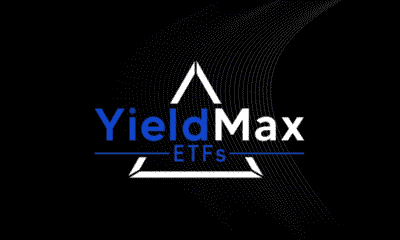
 Nyheter2 veckor sedan
Nyheter2 veckor sedanYieldMax® lanserar sin andra produkt för europeiska investerare
-
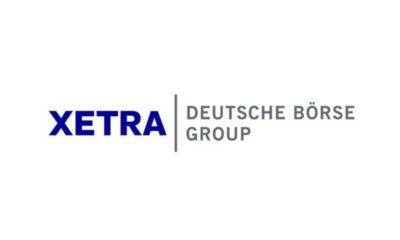
 Nyheter3 veckor sedan
Nyheter3 veckor sedanNya börshandlade produkter på Xetra
-

 Nyheter2 veckor sedan
Nyheter2 veckor sedan3EDS ETN ger tre gånger den negativa avkastningen på flyg- och försvarsindustrin
-
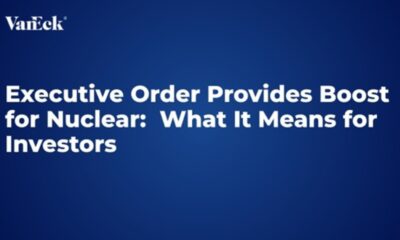
 Nyheter3 veckor sedan
Nyheter3 veckor sedanBig News for Nuclear Energy—What It Means for Investors
-
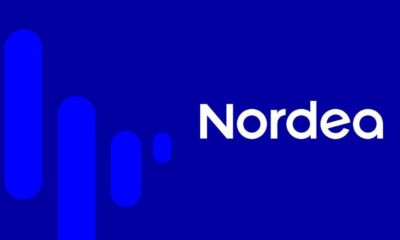
 Nyheter1 vecka sedan
Nyheter1 vecka sedanNordea Asset Management lanserar nya ETFer på Xetra
-

 Nyheter3 veckor sedan
Nyheter3 veckor sedanHANetfs VD Hector McNeil kommenterar FCAs kryptonyheter
-
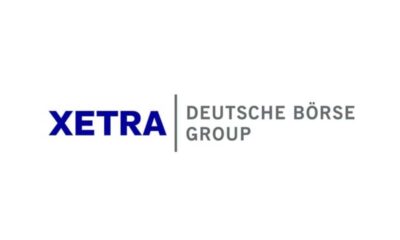
 Nyheter2 veckor sedan
Nyheter2 veckor sedanJPM noterar nya ETFer på Xetra och Börse Frankfurt


